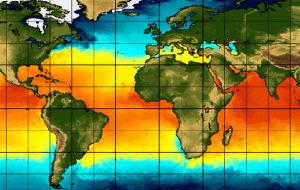MercoPress. South Atlantic News Agency
El Niño could again disrupt global food markets later this year
 Professor Scaife said there was a 70% chance of a “moderate” El Niño event towards the end of this year that is likely to lead to droughts and crop failures.
Professor Scaife said there was a 70% chance of a “moderate” El Niño event towards the end of this year that is likely to lead to droughts and crop failures. “We tend to see an increase in price of 5 to 10% on average for things like coffee, soybeans and cocoa” said Dr Klingaman of the University of Reading
“We tend to see an increase in price of 5 to 10% on average for things like coffee, soybeans and cocoa” said Dr Klingaman of the University of Reading  El Niño five years ago was linked with poor monsoons in SE Asia, droughts in south Australia, Philippines and Ecuador, blizzards in US, heat-waves in Brazil
El Niño five years ago was linked with poor monsoons in SE Asia, droughts in south Australia, Philippines and Ecuador, blizzards in US, heat-waves in Brazil A strong El Niño is likely to increase prices of staple foods such as rice, coffee, sugar and cocoa, say scientists. Forecasters agree that the El Niño effect, which can drive droughts and flooding, is under way in the tropical Pacific, but they say it is too early to say how severe it will be.
Reduced rainfall could be felt in India and West Africa as early as June, say scientists. The consequences of El Niño are much less clear for Europe and the UK, although they can lead to British winters that are dry with heavy snowfall.
“It's likely there will be at least a moderate El Niño this year” said Prof Adam Scaife of the UK Met Office. “I think there is very good agreement across the different [forecasting] centers that this is coming.”
Scaife said there was a 70% chance of a “moderate” El Nino event towards the end of this year that is likely to lead to droughts and crop failures.
Although it is too early to say how strong the event will be and whether it will persist throughout the year, a strong El Niño has the potential to “disrupt global food markets”, said Dr Nick Klingaman of the University of Reading.
He said coffee plantations in Brazil “already on the brink of failure” could be jeopardized, while reduced rainfall in Australia could affect banana and sugarcane crops as well as cattle herds. A moderately strong El Niño in 2002 was linked with a drier monsoon than normal in India, ruining crops such as groundnut and rice.
“Most El Niños historically have had a global impact on food prices,” he said. “We tend to see an increase in price of 5 to 10% on average for things like coffee, soybeans and cocoa.”
El Niño five years ago was linked with poor monsoons in Southeast Asia, droughts in southern Australia, the Philippines and Ecuador, blizzards in the US, heat-waves in Brazil and extreme flooding in Mexico.
Prof Eric Guilyardi of the University of Reading said current models point to an event on a similar scale to that of 2009/10, but perhaps as strong as in 1997/98, which was particularly extreme. However, he cautioned that “every El Niño is different, so its impacts are different”.
The warming of parts of the ocean is also likely to have a knock-on effect for global temperatures. “Global temperatures are very high and this is partly attributable to the El Nino evolving now,” said Prof Scaife.
El Niño is a warming of the Pacific Ocean as part of a complex cycle linking atmosphere and ocean. It comes along about every two to seven years as part of a natural cycle. Research suggests that extreme El Niño events will become more likely as global temperatures rise.




Top Comments
Disclaimer & comment rulesCommenting for this story is now closed.
If you have a Facebook account, become a fan and comment on our Facebook Page!